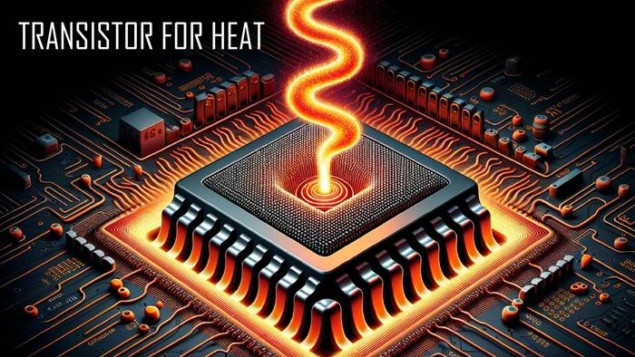
Researchers at the University of California in Los Angeles, US, have invented a thermal transistor that uses an electric field to control the flow of heat. This proof-of-concept device is the first of its kind, and its developers say it could be used to cool computer chips or even to reveal how living cells regulate heat at the molecular level.
Electrical transistors are semiconductor devices that regulate how electricity (electrons) move through a chip, and they are widely used to amplify or switch electrical signals and power. They are the building blocks of modern information technology, and their ever-decreasing size means that billions can now be squeezed onto a single chip.
The problem with this increasing density is that electrons generate significant amounts of heat as they propagate. If this heat is not removed, the chip’s performance will begin to degrade. Conventional heat sinks address this by passively drawing heat away from hot areas, but a more dynamic way to regulate heat transport has been lacking. This is because the dissipative nature of heat flow, the spectral distribution of heat carriers (phonons) and the fact that heat generally reacts very weakly with external fields all make the precise flow of heat through materials very difficult to control, explains Yongjie Hu, a mechanical and aerospace engineer who led the new research effort.
Hu and colleagues made their new thermal transistor from a self-assembled molecular interface that acts a conduit for heat. Switching an electric field on and off through a third-terminal gate provides field-effect controls over the atomic bonding dynamics of the interface material and therefore the thermal resistance across it. The result is a device with a switching speed of more than 1 MHz and a thermal conductance ratio of more than 1300% that can be switched more than 1 million times.
“Our new design principle is a big step forward in the field since it manages heat movement with the on-off switching of an electric field, just as what has been done with electrical transistors for decades,” Hu tells Physics World. “This is a very exciting emerging and rapidly evolving area of research, and we are working on novel concepts and designs to make revolutionary developments, just like our predecessors have done in the field of electrical transistors that revolutionized modern information technology.”
Implications for thermal management
Hu thinks the team’s work could have implications for thermal management in electronics, 3D integrated circuit packaging, sustainable energy systems, industrial processing and biomedical thermal therapy. He adds that the concept also offers a new way to understand heat management in the human body at the molecular-level mechanisms active within living cells.

Thermal transport goes ballistic across 2D thin films
Spurred on by their preliminary results, the researchers, who detail their present work in Science, say they are now exploring ways to improve the performance of their thermal transistors by optimizing their structures and materials. “We are also integrating these advanced thermal transistors into power circuits, such as 3D integrated circuits and chiplet designs,” Hu reveals. “By leveraging these thermal transistors with nanoscale precision control, our system aims to achieve significantly improved computing performance and reliability, surpassing current state-of-the-art technologies.”



